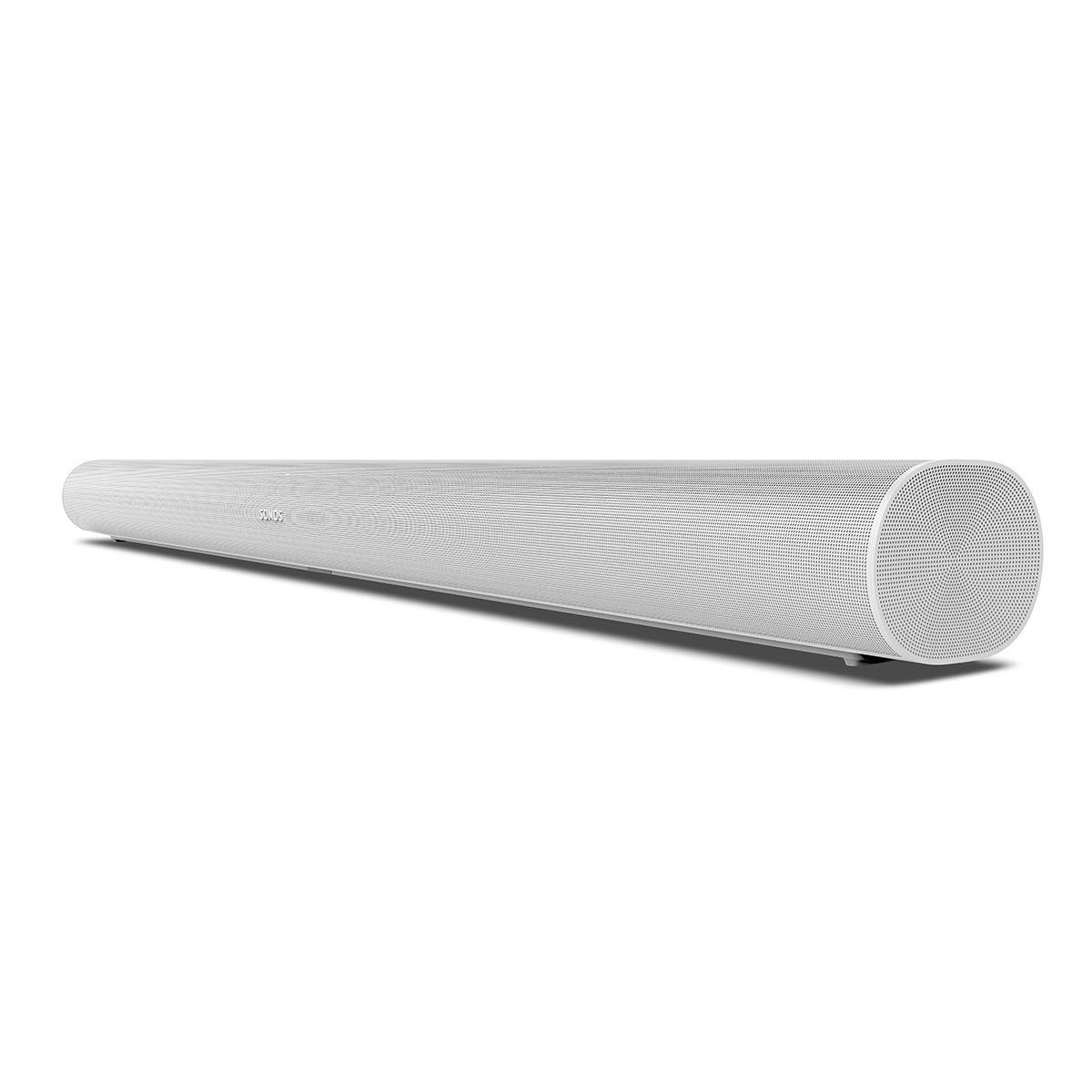
When it comes to upgrading your TV's sound, today's premium soundbars offer impressive capabilities that can transform your viewing experience. Let's dive deep into comparing two popular options: the Sonos Arc ($564) and the Klipsch Flexus Core 100 ($350).
Soundbars have evolved significantly in recent years, moving from simple TV speaker replacements to sophisticated audio systems. The key innovations driving this evolution include Dolby Atmos support (which creates three-dimensional sound), smart home integration, and improved wireless connectivity.
The Sonos Arc, released in 2020, represented a major leap forward in soundbar technology, while the Klipsch Flexus Core 100 arrived in early 2024 with a fresh approach to standalone performance. These products take notably different approaches to delivering high-quality audio, each with distinct advantages.

The Sonos Arc employs an impressive 11-driver array, including dedicated up-firing speakers for Dolby Atmos effects. This means when a helicopter flies overhead in a movie, you'll actually hear the sound moving above you. The speaker arrangement creates a wide, tall soundstage that fills larger rooms effectively.
In contrast, the Klipsch takes a more focused approach with its four-driver system. While it lacks true Atmos capability, it includes dual built-in subwoofers that provide surprisingly robust bass without needing a separate subwoofer. This makes it particularly strong for music and dialogue-heavy content.
The Arc's sound signature is more refined and spacious, while the Flexus Core 100 delivers a punchier, more direct presentation. For pure audio quality in movies, the Arc pulls ahead, especially in scenes with complex sound effects. However, the Klipsch holds its own for music playback, with excellent stereo separation and impressive bass response.
In practical use, room size and layout significantly impact performance. The Arc's Trueplay tuning (which uses your iPhone's microphone to optimize sound for your specific room) gives it an advantage in challenging spaces. The Klipsch lacks room correction but performs consistently well in medium-sized rooms thanks to its focused sound profile.
For dialogue clarity, both perform admirably, but the Arc's center channel configuration edges ahead, especially during complex action scenes. The Klipsch compensates with strong vocal presence in its default tuning.

Here's where the price difference becomes apparent. The Arc functions as a full-fledged smart speaker with built-in voice assistants (Google Assistant and Alexa) and integrates seamlessly with the Sonos ecosystem. This means you can:
The Klipsch takes a more streamlined approach, focusing on core audio functionality. While it lacks smart features, its simpler nature means fewer potential complications and a more straightforward setup process.

Both soundbars feature HDMI eARC, which enables high-quality audio passthrough including Dolby Atmos. The Arc adds:
The Klipsch offers:
The Sonos Arc at $564 represents a premium investment, but its feature set and ecosystem integration justify the cost for many users. The Klipsch Flexus Core 100 at $350 delivers excellent per-dollar performance, especially for users focused primarily on audio quality.

Consider future expansion costs: The Arc might need a subwoofer ($749) for optimal performance, while the Klipsch performs well standalone but can be expanded with wireless surrounds and a sub if desired.
For dedicated home theater use, the Arc's Atmos capability and room-filling sound make it the superior choice, especially in larger spaces. The Trueplay tuning helps optimize performance for your specific room, though this feature requires an iOS device.
The Klipsch excels in smaller to medium-sized rooms where its focused sound signature and built-in bass can create an engaging experience without additional components.
Both handle music well, but with different strengths:
For gaming, the Arc's Atmos support enhances immersion in compatible titles. The Klipsch's lower latency over Bluetooth can be advantageous for casual gaming setups.
Choose the Sonos Arc if:
Choose the Klipsch Flexus Core 100 if:
The soundbar market continues to evolve, with both companies likely to release updated models. The Arc's software-updatable nature means it continues to receive new features and improvements, while the Klipsch's newer release date suggests current-generation hardware capabilities.
Remember that both soundbars represent significant upgrades over TV speakers, and your specific needs should guide the choice between the Sonos Arc's premium, feature-rich experience and the Klipsch Flexus Core 100's focused, high-value performance.
| Sonos Arc | Klipsch Flexus Core 100 |
|---|---|
| Price - Base investment before any accessories | |
| $564 | $349 |
| Sound Configuration - Determines audio quality and immersion | |
| 11 drivers including upward-firing for true Atmos | 4 drivers (2x 2.25" drivers + 2x 4" built-in subs) |
| Bass Performance - Critical for movie impact | |
| Moderate bass, requires optional sub for best performance | Strong built-in bass from dual integrated subwoofers |
| Dolby Atmos Support - Creates 3D surround effect | |
| Full Atmos with dedicated height channels | Atmos processing only, no height channels |
| Smart Features - Convenience and future-proofing | |
| Built-in Alexa/Google Assistant, AirPlay 2, WiFi streaming | Basic Bluetooth streaming only |
| Room Correction - Optimizes sound for your space | |
| Trueplay tuning (iOS devices required) | No room correction features |
| Expandability - Future system growth | |
| Full Sonos ecosystem, wireless surrounds, sub | Limited wireless surrounds and sub options |
| Physical Size - Consider TV and room fit | |
| 45" x 3.4" x 4.5" (requires more width) | 28" x 3" x 5" (more compact design) |
| Connectivity - Audio input options | |
| HDMI eARC, optical, WiFi, Ethernet | HDMI eARC, optical, Bluetooth, USB-C |
| Power Output - Impacts maximum volume | |
| Not specified (typically performs well in large rooms) | 100W RMS (suitable for medium rooms) |
| Multi-room Capability - Whole home audio | |
| Full Sonos multi-room audio support | No multi-room capabilities |
| Voice Control - Hands-free operation | |
| Built-in microphones for voice commands | No voice control features |
The Sonos Arc is better for movies due to its true Dolby Atmos support and wider soundstage. While the Klipsch Flexus Core 100 offers good movie performance, it lacks the immersive 3D sound capabilities of the Arc.
If you value smart features, Dolby Atmos, and multi-room audio, the Sonos Arc justifies its $564 price. However, if you only need great sound quality, the Klipsch Flexus Core 100 at $349 offers excellent value.
The Klipsch Flexus Core 100 includes dual built-in subwoofers and provides strong bass without an external sub. The Sonos Arc benefits significantly from adding a separate subwoofer for optimal bass performance.
Both perform well, but differently. The Klipsch Flexus Core 100 offers excellent stereo separation and strong bass, while the Sonos Arc provides better streaming options and whole-home audio capability.
The Sonos Arc has built-in voice assistants (Google Assistant and Alexa) for full voice control. The Klipsch Flexus Core 100 does not offer voice control features.
The Klipsch Flexus Core 100 is more suitable for small to medium rooms due to its compact 28-inch width. The Sonos Arc at 45 inches wide is better suited for larger rooms and TVs.
Yes, both the Sonos Arc and Klipsch Flexus Core 100 support HDMI-CEC, allowing control through your TV remote for basic functions.
The Sonos Arc offers superior wireless connectivity with WiFi, AirPlay 2, and ethernet options. The Klipsch Flexus Core 100 is limited to Bluetooth connectivity.
Both support streaming, but differently. The Sonos Arc offers WiFi streaming through the Sonos app and AirPlay 2, while the Klipsch Flexus Core 100 uses Bluetooth.
Both the Sonos Arc and Klipsch Flexus Core 100 come with necessary HDMI cables and support HDMI eARC for best performance.
The Klipsch Flexus Core 100 offers simpler plug-and-play setup. The Sonos Arc requires more initial setup but offers more customization options.
Yes, both the Sonos Arc and Klipsch Flexus Core 100 can be wall-mounted and include mounting hardware or have compatible mounting accessories available.
We've done our best to create useful and informative comparisons to help you decide what product to buy. Our research uses advanced automated methods to create this comparison and perfection is not possible - please contact us for corrections or questions. These are the sites we've researched in the creation of this article: whathifi.com - soundandvision.com - en.community.sonos.com - cnet.com - worldwidestereo.com - abt.com - creativeaudio.net - target.com - sonos.com - worldwidestereo.com - businessinsider.com - en.community.sonos.com - youtube.com - cnet.com - klipsch.com - klipsch.com - bestbuy.com - sweetwater.com - assets.onkyo-av.com - youtube.com - worldwidestereo.com - avnirvana.com - target.com